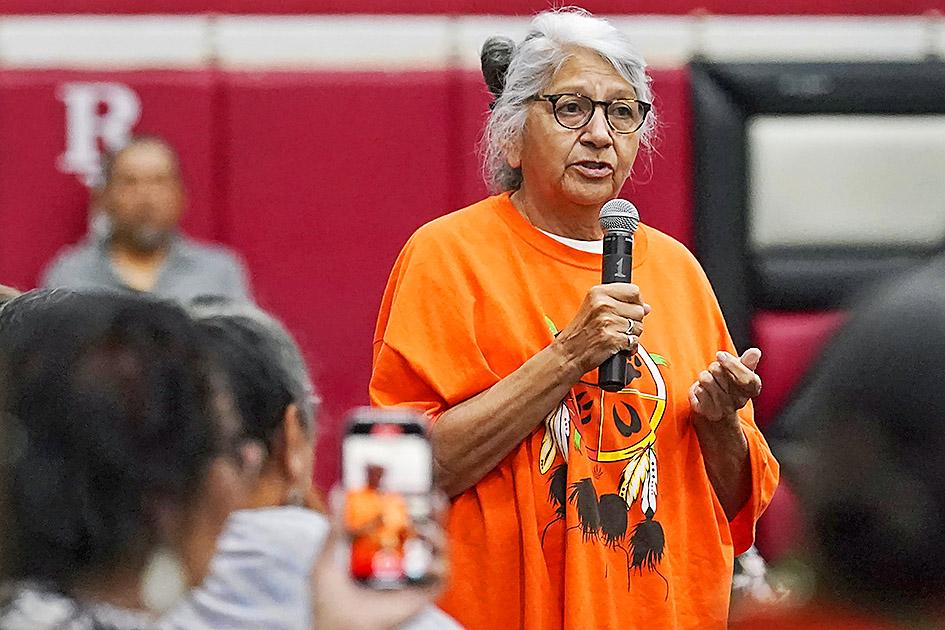South Dakota Gov. Kristi Noem on Monday released a revised proposal for social studies standards in public schools that lays out a mostly shining vision of American history, after an initial draft of the standards came under heavy criticism last year from conservatives and Native American educators.
The Republican governor claimed the new proposed standards are free from “political agendas” and include an increased focus on Native American history.
But they received swift criticism from some educators as a thinly-veiled political document. They emphasize the qualities of America’s founders and mimic language Noem has used as she jumped on the conservative cause of weeding certain “divisive” teachings on race from public schools.

Photo : AP
The 15-member standards workgroup, selected partially by the governor, included Noem’s chief of staff, two Republican lawmakers and the director of the South Dakota Catholic Conference, but just three educators certified by the Department of Education. The group’s work was facilitated by William Morrisey, a former professor at Hillsdale College — a conservative institution in Michigan that has tried to remake education across the country.
“South Dakota’s children deserve the very best social studies education in the nation,” Noem said in a statement. “These standards raise the bar for the breadth and depth of civics and history education. They feature a true, honest, and balanced approach to American history that is not influenced by political agendas.”
’TRUE AND HONEST HISTORY’

Photo : AP
Noem, who is seen as a potential 2024 White House contender, has also advocated for the “1776 Pledge to Save Our Schools” as part of a conservative drive to emphasize the qualities of the founders of the US. She has also tried to purge so-called critical race theory from the state’s public schools.
Despite the academic framework being one of her favorite targets, her administration has provided scant evidence that teaching associated with critical race theory — an academic framework that centers on the idea that racism is systemic in the nation’s institutions and that those institutions maintain the dominance of white people — exists in South Dakota schools. The state Department of Education spent hundreds of hours combing through its policies, guidance materials and Web sites, but its report released Monday found “a very small number” of instances where its material didn’t line up with Noem’s order to get rid of anything that contained “divisive concepts” on race.
The governor in a statement cast the report as “proactively removing” critical race theory as she promotes “America’s true and honest history.”
The social studies standards, which provide a list of topics students should comprehend at each K-12 grade level, give her an opportunity to stamp that vision of US history on the state’s public schools. They are widely followed by school districts but are not mandatory.
The new 128-page document more than doubles the length of the proposed standards the Department of Education released last year. They would make the sprawling argument that the US, though not without fault, is an exceptional nation that has uniquely advanced rights for every race and gender. They are also peppered with Christian history and explore the religion’s influence on the nation’s leading figures and on Western civilization.
PERPETUATING IGNORANCE
For example, seventh grade students are expected to explain how the nation’s founders advanced equal rights for every person and advanced the idea that each person “is endowed with these rights by the God that created them, and that the existence of human slavery was understood by most, but not all, of the founders to be a contradiction of the principle of human equality.”
Seventh graders are also to be taught: “Patriotism is the love of country, meaning that one holds his or her country up to an objective standard of moral right and wrong, preserving the ways in which the country does good and correcting the ways it sometimes does wrong.”
The standards state they are intended, in part, to “foster a love of country that, like any love, is not blind to faults.”
Nick Tilsen, the president of an Indigenous advocacy organization called NDN Collective, said that when the standards start out with goals like that, they are bound to further a narrative that continues to treat minority groups unjustly.
“Her approach in this curriculum further perpetuates ignorance, further perpetuates racism and white supremacy,” he said, adding “These priority areas are dominated by nationalism.”
The proposed standards are the Noem administration’s second attempt to update the learning objectives. Both the political left and right criticized last year’s standard-setting process and led Noem to scrap that proposal and relaunch the process. Noem’s new version, released Monday, appeased conservative critics.
Republican state Rep. Sue Peterson, who resigned in protest from last year’s workgroup, praised the new standards in a statement released by the governor’s office. She called them “substantial and straightforward standards that emphasize our founding documents, our pursuit of freedom, and treat our nation’s history honestly.”
Noem’s office also attempted to head off criticism from Native American education advocates and included a statement from Joe Circle Bear, a member of the Cheyenne River Sioux Tribe who was part of the workgroup.
“Governor Noem promised to tell our story as part of American history, and these standards do that,” Circle Bear said in the statement.
INDIGENOUS INCLUSIVITY?
The new standards ask schools to teach students about the “removal and relocation” of the Dakota, Lakota and Nakota, major battles and massacres in their history, the effects of forced boarding schools on Native Americans, as well as Indigenous leaders such as Crazy Horse, Sitting Bull and Spotted Tail. It also covers the Civil Rights Movement and its leading figures, such as Rosa Parks and Malcolm X.
But Native American educators, who protested after the Department of Education last year cut references to Indigenous culture and history from a draft the workgroup submitted for final approval, said the new standards continued to push indigenous history and culture to the periphery.
“They are not inclusive to say the least. The goal was to get away from inclusivity to push an agenda that the governor deems important,” said Sarah White, who directs the South Dakota Education Equity Coalition. “It’s definitely going to further disenfranchise our students when it’s missing that indigenous lens.”
White said her group is strategizing how to weigh in on the social studies standards as they next become open to public comment at several hearings in the coming months. After the public comment period and potential revisions, the Board of Education Standards, which is appointed by the governor, will approve the new education standards.
White said, “We’re hopeful that we can pack the house at all the public hearings.”
The Department of Education is planning a separate review of the instructions for teachers included in the Oceti Sakowin Essential Understandings and Standards, which teach Lakota, Dakota and Nakota culture and history. The department also found two content standards in a technical education course called Introduction to Law and Public Safety II that ran afoul of Noem’s executive order. Even though those standards align with industry expectations for law enforcement training, the department said it would recommend changes to the courses.

On April 26, The Lancet published a letter from two doctors at Taichung-based China Medical University Hospital (CMUH) warning that “Taiwan’s Health Care System is on the Brink of Collapse.” The authors said that “Years of policy inaction and mismanagement of resources have led to the National Health Insurance system operating under unsustainable conditions.” The pushback was immediate. Errors in the paper were quickly identified and publicized, to discredit the authors (the hospital apologized). CNA reported that CMUH said the letter described Taiwan in 2021 as having 62 nurses per 10,000 people, when the correct number was 78 nurses per 10,000

As Donald Trump’s executive order in March led to the shuttering of Voice of America (VOA) — the global broadcaster whose roots date back to the fight against Nazi propaganda — he quickly attracted support from figures not used to aligning themselves with any US administration. Trump had ordered the US Agency for Global Media, the federal agency that funds VOA and other groups promoting independent journalism overseas, to be “eliminated to the maximum extent consistent with applicable law.” The decision suddenly halted programming in 49 languages to more than 425 million people. In Moscow, Margarita Simonyan, the hardline editor-in-chief of the

Six weeks before I embarked on a research mission in Kyoto, I was sitting alone at a bar counter in Melbourne. Next to me, a woman was bragging loudly to a friend: She, too, was heading to Kyoto, I quickly discerned. Except her trip was in four months. And she’d just pulled an all-nighter booking restaurant reservations. As I snooped on the conversation, I broke out in a sweat, panicking because I’d yet to secure a single table. Then I remembered: Eating well in Japan is absolutely not something to lose sleep over. It’s true that the best-known institutions book up faster

Though the total area of Penghu isn’t that large, exploring all of it — including its numerous outlying islands — could easily take a couple of weeks. The most remote township accessible by road from Magong City (馬公市) is Siyu (西嶼鄉), and this place alone deserves at least two days to fully appreciate. Whether it’s beaches, architecture, museums, snacks, sunrises or sunsets that attract you, Siyu has something for everyone. Though only 5km from Magong by sea, no ferry service currently exists and it must be reached by a long circuitous route around the main island of Penghu, with the